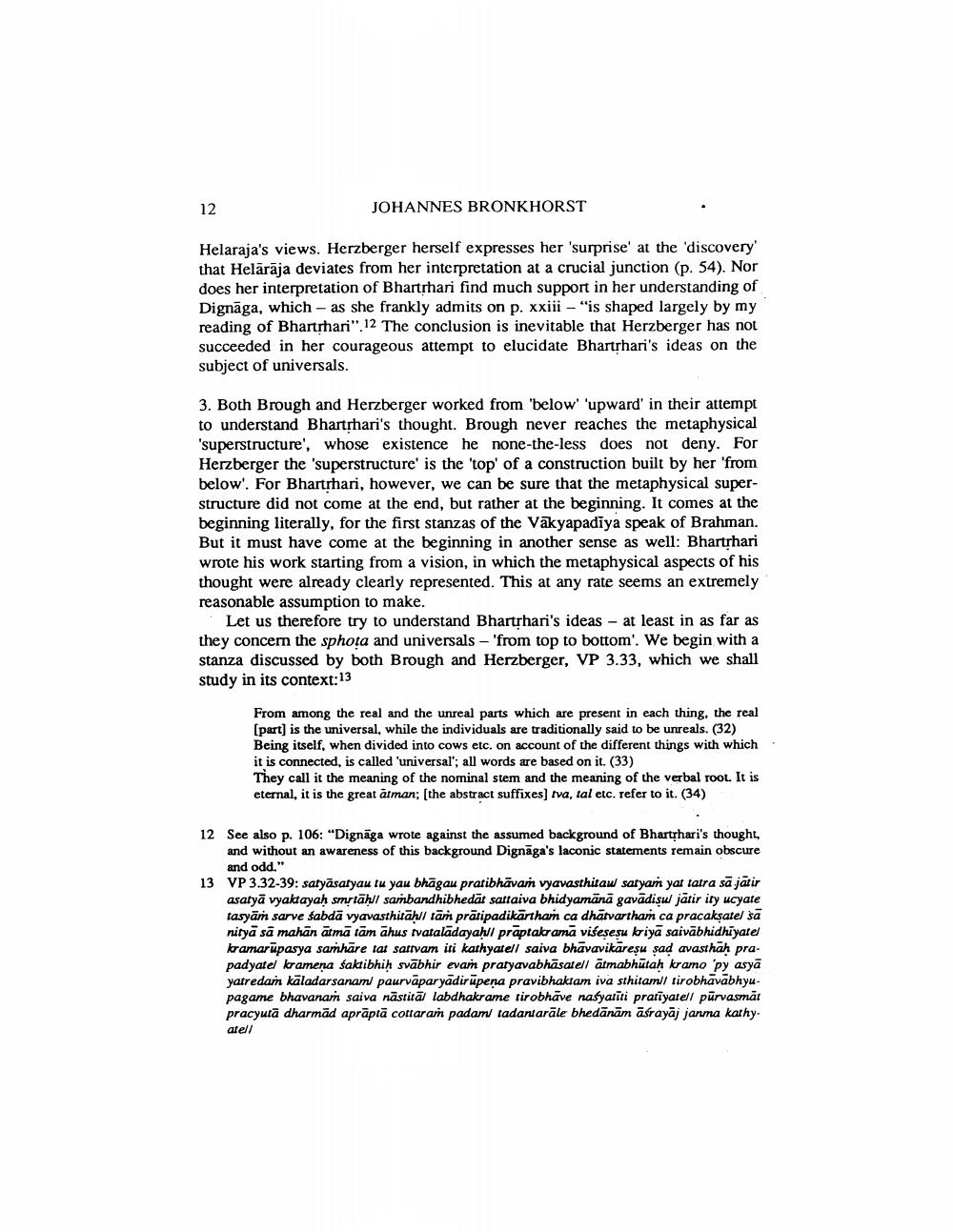Book Title: Studies On Bhartrhari 3 Author(s): Johannes Bronkhorst Publisher: Johannes Bronkhorst View full book textPage 8
________________ 12 JOHANNES BRONKHORST Helaraja's views. Herzberger herself expresses her 'surprise at the discovery that Helārāja deviates from her interpretation at a crucial junction (p. 54). Nor does her interpretation of Bhartrhari find much support in her understanding of Dignāga, which - as she frankly admits on p. xxiii - "is shaped largely by my reading of Bhartrhari". 12 The conclusion is inevitable that Herzberger has not succeeded in her courageous attempt to elucidate Bhartrhari's ideas on the subject of universals. 3. Both Brough and Herzberger worked from below' 'upward' in their attempt to understand Bhartrhari's thought. Brough never reaches the metaphysical 'superstructure', whose existence he none-the-less does not deny. For Herzberger the 'superstructure is the 'top' of a construction built by her 'from below'. For Bhartrhari, however, we can be sure that the metaphysical superstructure did not come at the end, but rather at the beginning. It comes at the beginning literally, for the first stanzas of the Vakyapadiya speak of Brahman. But it must have come at the beginning in another sense as well: Bharthari wrote his work starting from a vision, in which the metaphysical aspects of his thought were already clearly represented. This at any rate seems an extremely reasonable assumption to make. Let us therefore try to understand Bharthari's ideas - at least in as far as they concern the sphota and universals - 'from top to bottom'. We begin with a stanza discussed by both Brough and Herzberger, VP 3.33, which we shall study in its context:13 From among the real and the unreal parts which are present in each thing, the real (part) is the universal, while the individuals are traditionally said to be unreals. (32) Being itself, when divided into cows etc. on account of the different things with which it is connected, is called 'universal'; all words are based on it. (33) They call it the meaning of the nominal stem and the meaning of the verbal rool. It is eternal, it is the great atman; (the abstract suffixes) tva, tal etc. refer to it. (34) 12 See also p. 106: "Dignāga wrote against the assumed background of Bhartīhari's thought, and without an awareness of this background Dignāga's laconic statements remain obscure and odd." 13 VP 3.32-39: satyāsatyau tu yau bhāgau pratibhāvan vyavasthitam satyam yat tatra sā jātir asatyā vyaktayah smrtā // sambandhibhedāt sattaiva bhidyamānā gavādişul jātir ity ucyate tasyāṁ sarve sabda vyavasthitā I tām prātipadikārtham ca dhatvartham ca pracaksatel sa nityā sa mahān ātmā tām āhus tvataladayaḥ/l prāptakramā viśesesu kriyā saivābhidhiyatel kramarūpasya samhäre tat sattvam iti kathyatell saiva bhāvavikāresu sad avasthāh prapadyatel kramena saktibhih svābhir evam pratyavabhāsatell ātmabhūtah kramo 'py asyā yatredam käladarsanam/ paurvāparyadirupena pravibhaktam iva sthitam/l tirobhāvābhyupagame bhavanam saiva năstitā labdhakrame tirobhāve nasyatīti pratīyatell pūrvasmā! pracyutā dharmād aprāptā cottaram padam/ tadantarāle bhedānām āśrayāj janma kathy atellPage Navigation
1 ... 6 7 8 9 10 11 12 13 14
